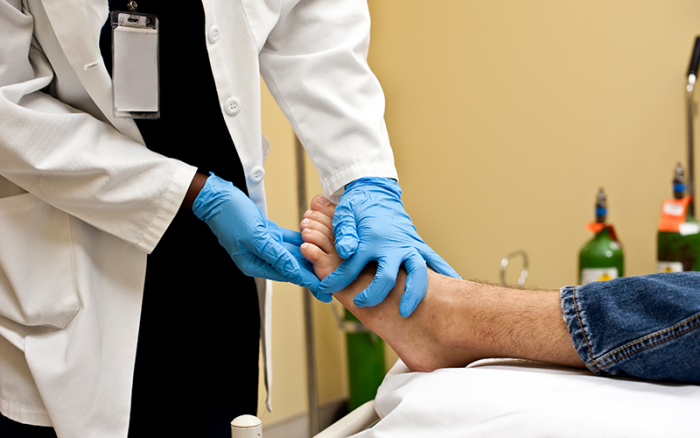Dermatologists often see patients concerned about a black spot under their nail. While it could be an indication of skin cancer, there are many other conditions that present this symptom. If you’re concerned about a black spot under your toenail, keep these details in mind and schedule an appointment with your provider right away.
Sign of Skin Cancer
There are different types of skin cancer, each named for the type of skin cell from which they originate. Most skin cancers fall into one of three categories: basal cell carcinoma, squamous cell carcinoma, and melanoma.
A black spot under the nail can indicate a type of melanoma called acral lentiginous melanoma (ALM). These melanomas can appear anywhere on the body, including underneath fingernails and toenails. The sub-type of ALM that affects the nail is called subungual melanoma. Subungual melanoma is rare and typically involves the nail of the big toe or thumb. It often presents as a dark spot or streak in its early stages.
“The most important warning sign of melanoma is a new spot on the skin or a spot that changes in size, shape or color,” says Dr. Alex Jack, a certified dermatologist with U.S. Dermatology Partners Kyle. “A dark spot or streak under the nail should be looked at by a dermatologist right away, especially if you haven’t recently experienced an injury to the area.”
People who have extended or frequent exposure to ultraviolet (UV) rays are at greater risk for melanoma. In fact, 90% of melanoma can be linked to exposure to UV rays. However, there are some cases that occur with little to no exposure, so never assume that you’re not at risk.
Other Skin Conditions
There are many other conditions that can present a black spot under the toenail. While it’s always a good idea to consult with your doctor, keep these skin conditions in mind before making an appointment.
Nail Trauma: If you’ve recently injured the area, the black spot under the nail may be a type of bruise referred to as a subungual hematoma. As a result of an injury, blood pools under the nail leading to discoloration. This type of hematoma is commonly caused by stubbing a toe or from sports trauma. While painful, subungual hematomas rarely need treatment.
Nail Fungus: There are many different symptoms of nail fungus, but discoloration of the nail is usually the first sign. Some nails turn yellow, brown or green. Initially, you may only see a spot of discoloration on the nail. Nail fungus should be diagnosed and treated by a dermatologist right away to protect the integrity of the nail and to prevent it from spreading to others.
Nail Psoriasis: Psoriasis can affect both the fingernails and toenails. In some cases, it can cause the nail to become detached from the nail bed, creating a gap underneath the nail. Bacteria can enter this gap, which then produces a dark green pigment. This is frequently mistaken for melanoma under the nail. Luckily, a dermatologist can provide many treatments for psoriasis to help improve or save the integrity of the nail.
Remember, only a dermatologist can tell you if the black spot is a symptom of these conditions or skin cancer.
Diagnosing the Problem
If you’re concerned about a black spot under the nail, it’s important to schedule an appointment with a dermatologist right away. “Early diagnosis and treatment are critical to increasing the chances of curing cancer,” says Dr. Jack. “Your doctor will want to know when you first noticed the change in your skin, symptoms and your history.”
If your doctor suspects skin cancer, he or she will likely diagnose through a biopsy. The dermatologist will numb the area, then remove all or a portion of the suspicious area. The tissue is usually sent to a lab to be examined under a microscope by a dermatopathologist.
Looking to Visit a Dermatologist?
Black spots under the toenail can be concerning and shouldn’t be ignored. Are you worried about a black spot under your toenail? We can help. To learn more, contact U.S. Dermatology Partners today to make an appointment with one of our board-certified dermatologists. We have multiple locations throughout the country, so fill out our simple online form to get in touch with us. One of our local team members will reach out to you shortly to answer your questions or schedule an appointment for you to visit us soon.
Find a location near me
or

